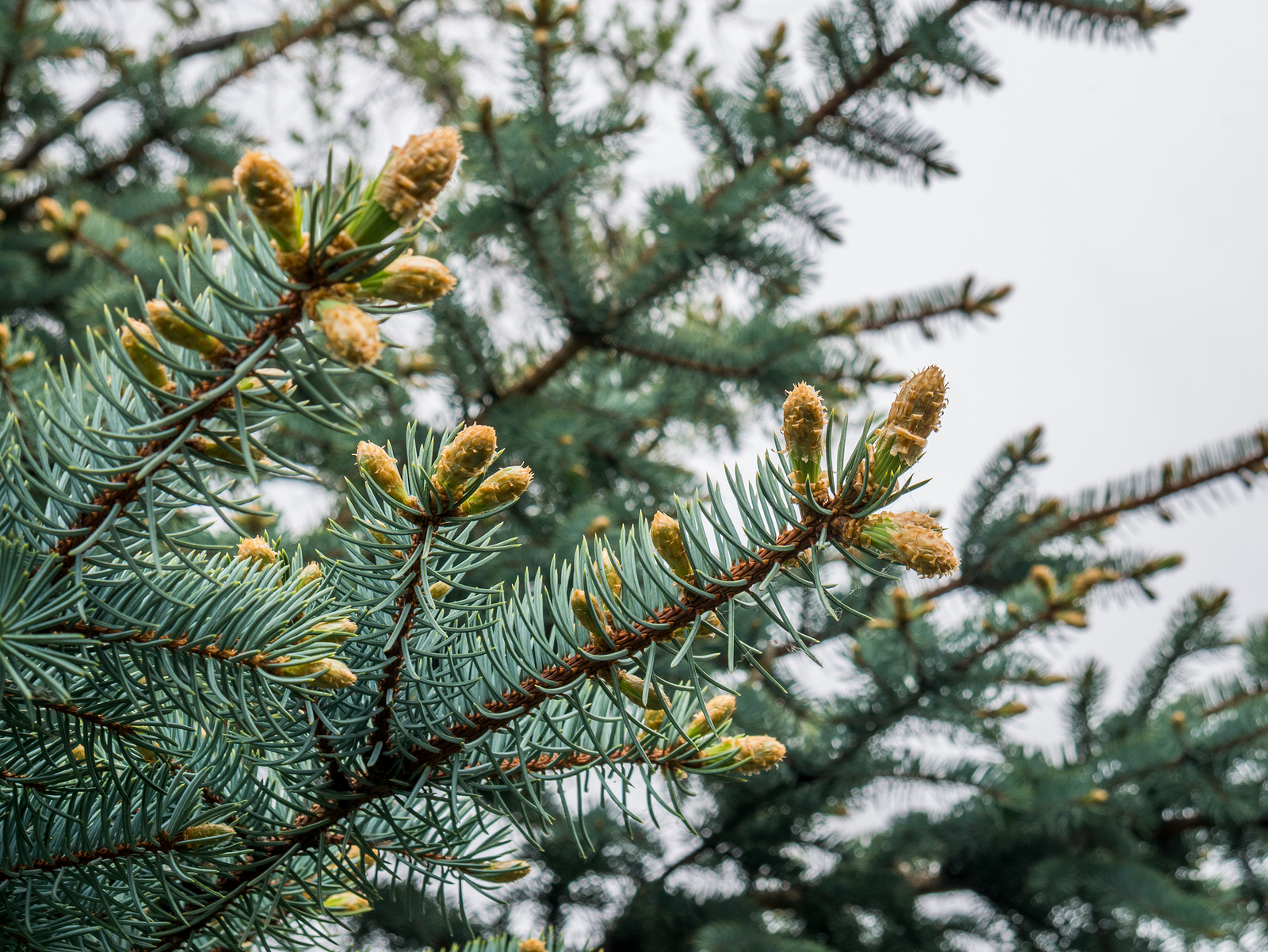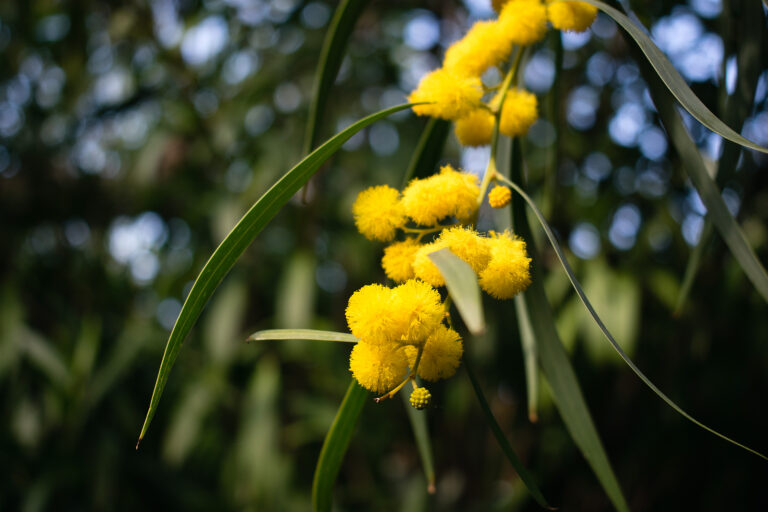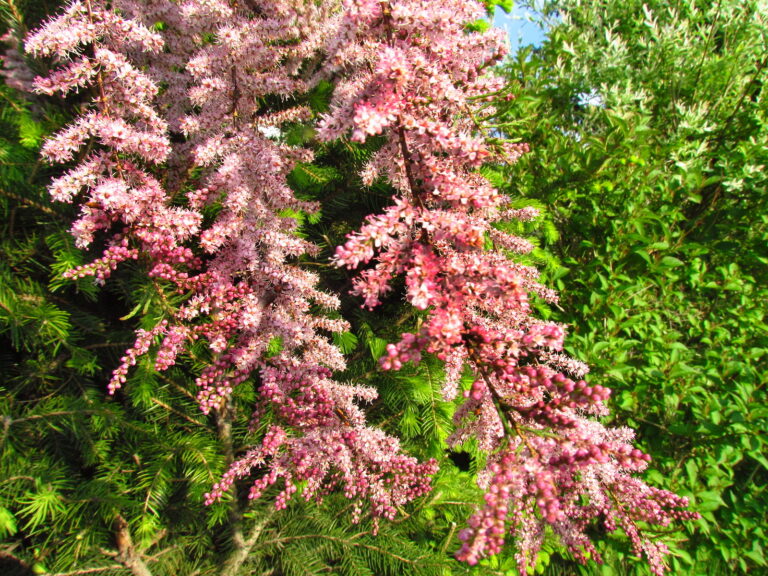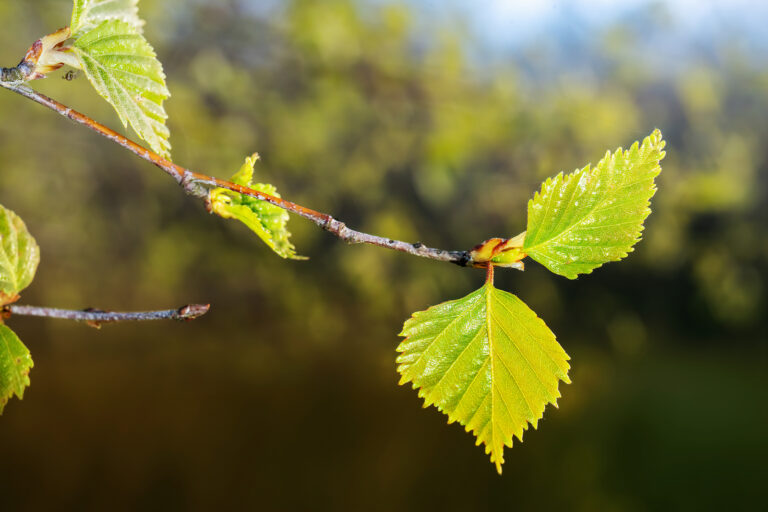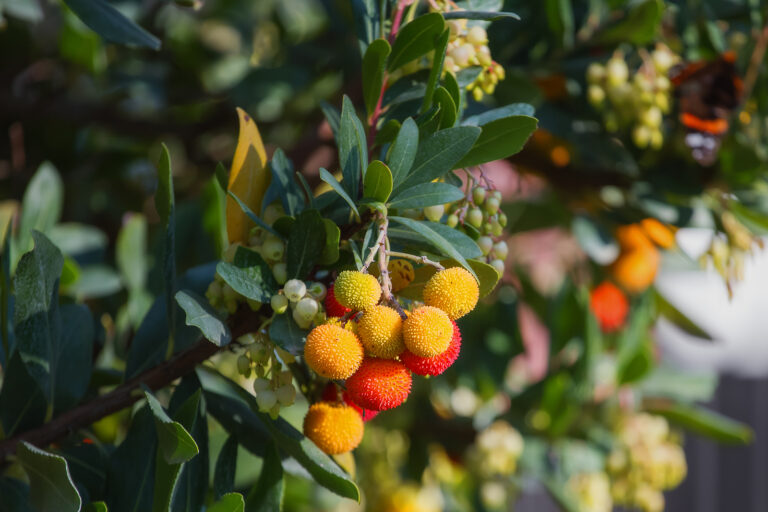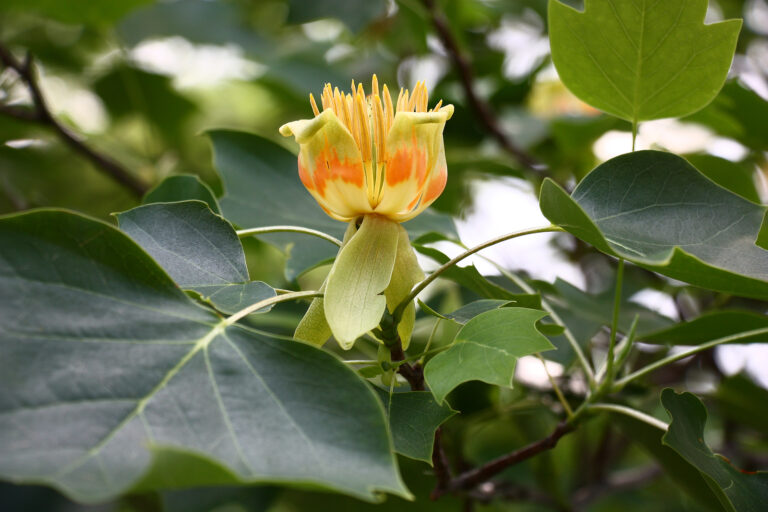How to Grow Spruce – Picea
Spruce is the common name for Picea, a genus of evergreen trees of the Pine Family.
Spruce have whorled branches, narrow needle-like leaves, and fruit which is usually a pendant cone. Drooping cones distinguish spruces from firs that bear upright cones.
Spruces are exceedingly ornamental. Large spruces are especially valuable for park or estate planting and the slower-growing species are suited for home gardens.
Most spruces are hardy and tolerant of shade. They will grow in almost any kind of soil if there is good drainage and sufficient moisture. Because they are shallow-rooted, spruces are easily transplanted.
Their dense foliage and strong branches make them excellent windbreaks or shelterbelts. Some species such as the Norway spruce or Tigertail spruce can endure severe pruning and are often used as hedge plants.
Spruces can be grown from seed or cuttings.
Here are often grown spruce varieties:
- Norway Spruce, Picea abies, grows to 150 feet tall, has pyramidal form with horizontal branches and shiny dark-green needles. It is among the most commonly cultivated evergreens.
- White Spruce, P. glauca, grow to 70 feet with ascendant branches and drooping branchlets; it is blueish-green and strongly aromatic.
- Colorado Spruce, P. pungens, grows from 80 to 150 feet tall in pyramidal form; its foliage is striking bluish-green to silvery white.
- Tigertail Spruce, P. polita, grows to 90 feet; it has stout branches and can be pruned into hedge form.
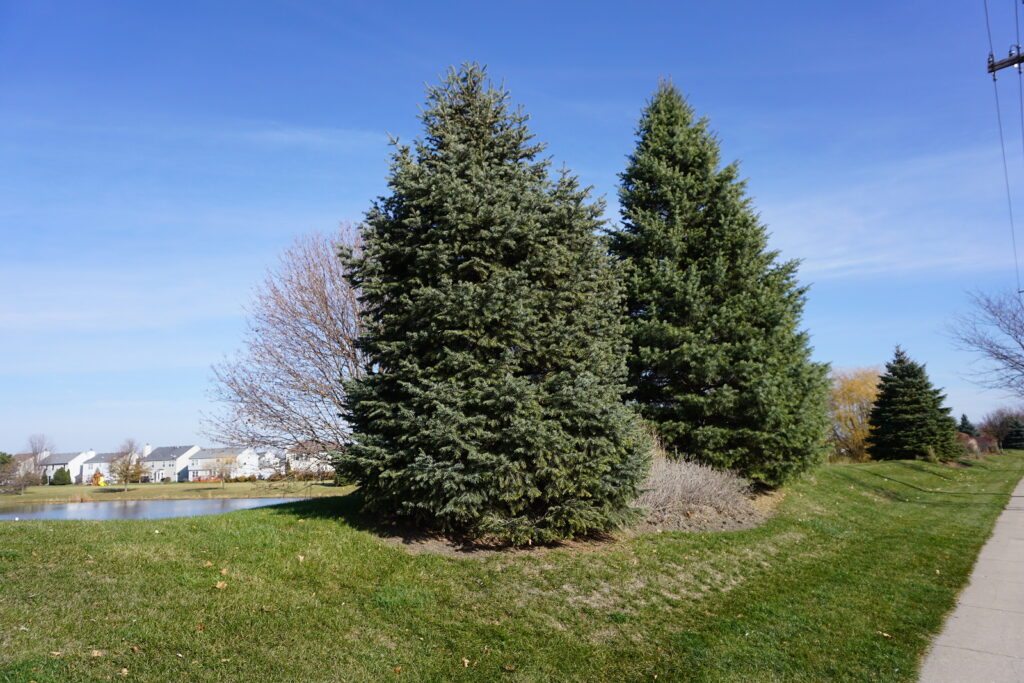
Get to know Picea
- Plant type: Evergreen conifer
- Growing zones and range: USDA Zones 4 to 7
- Hardiness: Hardy to Zone 4
- Height and width: 50-60 feet (15.2-18.3m) in cultivation
- Growth rate: Slow
- Form and habit: Pyramidal and conical
- Foliage: Whorled branches with needles that are usually four angled and spirally arranged on branchlets
- Flowers:
- Fruits: Cones are oval or elongated and typically hang down, remaining on tree without shattering; they ripen in season from green or red when young, to purple or brown when mature
- Bloom time: Spring
- Uses: Gardens, large-scale landscapes, shelter, specimen trees
- Garden companions:
- Common name: Spruces
- Botanical name: Picea
- Family name: Pinaceae
- Origin: North America, Europe, and Asia, mostly from cool, moist regions
Where to plant Picea
- Plant Picea in full sun.
- Plant Picea in deep, humus-rich, moisture-retentive, fairly neutral soil that drains well.
- Picea will tolerate clay soil, but not heat, drought, or pollution.
- When young, most Picea can benefit from wind protection.
- Picea grow best in regions where summers are cool or mild, not hot and humid.
When to plant Picea
- Young Picea container-grown or balled-and-burlapped plants transplant easily in early spring or fall.
- Sow seed in containers in a cold frame in spring.
Planting and spacing Picea
- Space trees 50 or more feet apart if growing to full-size.
- When planting larger Picea, don’t place them too close to buildings, fences, or walks; they need space.
- Because of their shallow root system, amend a planting area that is wide but not especially deep.
- Mulch to improve moisture retention.
How to water and feed Picea
- Keep the soil evenly moist; grows best in moisture-retentive well-drained soil.
- Fertilize spruce by spreading aged compost to the dripline at least once a yea
- Give Picea regular to moderate water.
- Feed Picea with an all-purpose organic fertilizer in spring.
How to care for Picea
- Picea are most attractive if the lower branches are left to sweep to the ground.
- Prune Picea only to shape; if a branch grows too long, cut it back to a well-placed side branch.
- To slow growth and make it more dense, remove part of each year’s growth to force side branches.
- Take care not to injure plants with sharp gardening tools; such wounds are common entry points for pests and diseases.
- Mulch around Colorado spruce to keep the soil moist.
Picea common problems
- Avoid injuring the tree with a lawnmower or other tool; wounds can be points of entry for pests or diseases.
- Check Picea for aphids in late winter.
- Other common pests are bagworms (in eastern and central U.S.), spruce budworm (in northern regions), gall insects, caterpillars, sawfly, lesion nematode, scale insects, pine needle scale, and spider mites.
- If pests are present, take control measures promptly to avoid defoliation in spring.
- Butt rot, heart rot (and out wood rots), witches’ broom, mistletoe, rust, and needle cast can also be a problem.
Picea propagation
- Sow Picea seeds when ripe in fall or spring.
- Take Picea cuttings in fall.
- Take ripewood cuttings of dwarf cultivars in late summer.
- Graft Picea species in spring.
- Graft Picea cultivars in winter.
Picea varieties to grow
- P. abies, Norway spruce, this pyramidal tree reaches 90 feet (27.4m) tall and 35 feet (10.7m) wide and is quite stiff looking when young, although it becomes more open and graceful as it matures. The wide-spreading side branches are almost horizontal but turn downward and then upward at their tips. They are decorated with weeping twigs and branchlets that are densely cloaked with needles. The .5-1 inch (1.3-2.5cm) long needles are stiff and dark green and have a blunt point. Young cones are reddish purple in spring and ripen into 6 inch (15.2cm) long, light brown, cigar-shaped cylinders that hang from the upper branches all winter. Norway spruce has rough, reddish brown bark and is fast growing and very long-lived; it resists cold and wind. It grows to a large size that can dwarf many home landscapes, so plant it where it has plenty of room to expand, and take into account its dark, somber appearance. Useful as a specimen, screen, or windbreak. Large trees transplant well. From Europe. Zones 3 to 7.
- P. glauca, White spruce, when young, white spruce forms broad, dense pyramid with horizontal branches. It matures into a spirelike, pyramidal or columnar tree with ascending branches and ultimately grows to 50 feet (15.2m) tall and 20 feet (6.1m) wide. The .8 inch (2cm) long, pale blue-green needles are rigid with a barely sharp point. They have white bands on both sides, creating a less somber appearance than that of P. abies. The 2 inch (5.1cm) long cones are green in spring, ripen to pale brown in fallm and remain on the tree through the winter. Bark is rough and gray-brown. White spruce ultimately reaches a large size with branches all the way to the ground. Use it as a specimen where it has plenty of room to grow. This is the most heat-tolerant spruce. It adapts to coastal conditions. From northern North America. Zones 2 to 8.
- P. omorika, Serbian spruce, though not well known, this slow-growing spruce, with its narrow pyramidal shape and weeping branches, is perhaps the most elegant of the genus and one of the toughest, too. It reaches 60 feet (18.3m) tall and 20 feet (6.1m) wide, has short side branches that curve gracefully upward at their tips, and has somewhat pendulous branchlets, creating a distinctive silhouette. The dense, sharp-pointed, 1-1.5 inch (2.5-3.8cm) long needles are dark blue-green on top and gray-white on their undersides, which lends a two-tone effect. The 2 inch (5.1cm) long, cylindrical cones are dark blue-purple when young and turn cinnamon brown when mature. Use this narrow tree as a strong vertical accent in a mixed border. Unlike most spruces, it tolerates heat, humidity, and dry air. From western Europe. Zones 4 to 8.
- P. orientalis, Oriental spruce, less commonly grown then P. abies or P. glauca and much more beautiful, Oriental spruce forms a slow-growing, broad cone that reaches 60 feet (18.3m) tall and 20-30 feet (6.1-9.1m) wide. It has horizontal or slightly pendulous branches and short, stiff branchlets that are less pendulous than those of other spruces. The blunt-tipped, four-sided needles are noted for their fine texture and glossy, dark black-green color. They are only .3 inch (.8cm) long and are pressed tightly against the stems, creating very densely needles twigs. Cones are reddish purple in spring and mature to 3.5 inch (8.9cm) long, dangling, brown cones in fall. This very formal-looking spruce is best used as a specimen in a lawn or border. The golden-needled forms look best against dark green evergreens. This is one of the best spruces where summers are hot and humid. From eastern Europe and Asia Minor. Zones 4 to 8.
- P. pungens, Colorado blue spruce, this extremely dense, blue-needled tree forms a very symmetrical, 60 foot (18.3m) tall, 25 foot (7.6m) wide pyramid made up of tiers of stiff, horizontal branches and short, nonweeping branchlets. The sharp-pointed needles are about 1 inch (2.5cm) long and encircle the stems. The range in color from blue-gray to steel blue to powder blue; the species itself has gray-green to dark green needles. Cones are green when young and mature to shiny, light brown, 4 inch (10.2cm) long cylinders. This popular tree has a very formal shape that does not lend itself to all landscapes. Plant in a lawn as a specimen, in groups as a windbreak, or as a screen where there’s plenty of growing room. The best blue color develops in full sun. Looks best against dark green (not golden) evergreens. From western North America. Zones 3 to 7.

